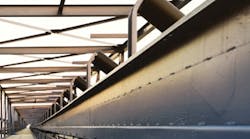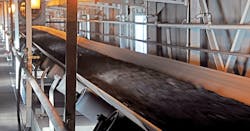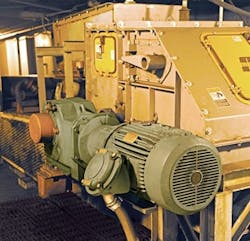Preventing Plant Shutdowns With Coal Conveying Confidence
Located four miles southeast of Stanton on the Missouri River, the plant is owned by Basin Electric Power Cooperative, one of the largest electric generation and transmission cooperatives in the United States. It generates and transmits wholesale, bulk electric power to 2.8 million customers in nine states (Figure 1).
When the 222-megawatt Unit 1 at Leland Olds Station went online in January 1966, it was the largest lignite-based power plant in the Western Hemisphere. Unit 2, a 447-megawatt unit located adjacent to Unit 1, began commercial operation in December 1975. In 2007, construction began on a $410-million project to install a wet limestone scrubber to remove sulfur dioxide emissions.
In general, the plant consumes about 3.3 million tons of lignite per year from North American Coal Corp.'s Freedom Mine in Beulah, N.D. The plant also uses about 230,000 gallons of water per minute—most of which is released back into the Missouri River. The plant's boilers produce 1005 °F steam, which spins Unit 1's 290,000-hp turbine and Unit 2's 590,000-hp turbine at 3600 rpm.
Leland Olds Station is the only power plant in North Dakota that uses a "v-slot" coal-unloading system. This v-shaped hopper and enclosure automatically unloads six rail cars at a time. It takes about one hour to unload a 60-car train (Figure 2).
'Musical Gearboxes'
Originally, chain cases were used on gearboxes serving the plant's conveyors, but due to issues with grease and improving plant cleanliness, the maintenance department switched to belt drives. However, we found the change from chains to belts added too much tension and overloaded the bearings in the gearboxes, and that's when the maintenance headaches began (Figure 3).
For years, we've been playing musical gearboxes on these conveyors. We would take a failing gearbox off and replace it with our spare, and hope that we could fix the gearbox before we needed the spare somewhere else on the line. Most of the time, we were scrambling to make these things work and keep the conveyors running.
Extra time was also needed to realign belts after a gearbox was installed, which is a critical job, requiring skill, time and effort. These change-outs were also complicated because of where the gearboxes are located—in confined, hard-to-reach spaces with not much room to work.
This was a big deal for us and the plant because failing gearboxes threatened our ability to generate power. While we never did lose generation, we had to sweat it out a few times to get the job done. We knew this was not a good situation, and we needed to do something about it.
Combining Reducers, Motors, Pulley and Shafting
Consequently, we called in a trusted distributor to help find a reliable solution. Craig Taylor, manager of Motion Industries' branch in Bismarck, N.D., had been a frequent visitor at the plant, and had helped our team with several other projects. Taylor was familiar with the failing gearboxes, and recommended Baldor's Dodge Quantis right-angle, helical bevel gear reducer.
"We've had good success using Dodge Quantis gearboxes in other applications over the past six years," explains Taylor. "They have a good service record, so there was no question about what Leland Old Station's conveyors needed."
Figure 4: To achieve more consistent gearbox performance, the plant's maintenance staff implemented Baldor's Dodge Quantis right-angle, helical bevel (RHB) reducers, Reliance Super-E premium-efficient, explosion-proof motors, Dodge pulleys and shafting, and Dodge Imperial bearings.
However, Taylor recommended more than just the gearbox. For added reliability, he suggested implementing a Baldor package that—in addition to the Quantis reducer—also included its Reliance Super-E explosion-proof premium-efficient motor, Dodge pulley and shafting components, and Dodge ISAF bearings (Figure 4).Taylor reports he worked with Baldor's System-1 group, which is a team that facilitates design, quotation and order processing of multiple power transmission and electrical products into one packaged solution. He adds it's beneficial to deal with one company and get one quote. Plus, he believes customers get better packages and prices as a result. We and other Leland Old Station officials agreed, and we ordered six of them.
Likewise, it was nice when the shipments arrived, because we didn't have to do a bunch of assembly here at the plant. The drum was already mounted on the shaft, and the bearings were mounted too. So, when we got the assembly into position, all we had to do was mount the gearbox and motor package. Our electricians hooked it up, and away we went.
Consistent Performance
Since they were installed in the fall of 2009, our Quantis reducers have performed flawlessly. They run great, and our team only looks at them while performing our regularly scheduled, preventive maintenance program. It's a nice change not to be worried about failing gearboxes, but we also appreciate the benefits of getting the power we need from a compact unit.
Because space is at a premium where the gearboxes are used, having a smaller unit makes it much easier for us to get to all of the other equipment. Another feature is that these gearboxes have a built-in, roll-back clutch, instead of a separate piece of equipment, which took up space and required additional maintenance. In general, fewer moving parts means there is a lot less for us to deal with.
We're also glad to have a Baldor Reliance motor as part of the package, especially the efficient design for energy savings. We have a lot of Reliance motors in the plant, and we've had good luck with them, too.
Figure 5: The plant's maintenance team reports its Dodge Imperial bearings have an adapter-style mounting that attaches to the shaft with 360° degrees of support, don't cause any shaft damage, and are easy to maintain.
In addition, the Baldor Dodge ISAF bearings were well received by our maintenance team (Figure 5). In the past, set screw bearings were used, but they caused severe damage to the shaft over time, which meant machining a new shaft as well as replacing the bearings. However, the Dodge bearings use an adapter-style mounting that attaches to the shaft with a concentric grip that reduces damage. We really like these bearings because they offer 360° of support. Because they support the shaft better, they won't cause any damage and are easy to maintain. These bearings have solved a lot of our problems.Thanks to all these solutions, we're enjoying maintaining the plant without the panic we experienced in the past from constantly failing gearboxes. Now when peak demand hits, I don't worry about meeting critical demand, because our Quantis reducers and other products have proven to be so reliable. We believe our strategy of choosing a package based on total cost of ownership was the right decision. Our maintenance headaches have gone away. It would be nice if everything worked this way.
Latest from Safety Instrumented Systems

Leaders relevant to this article:








